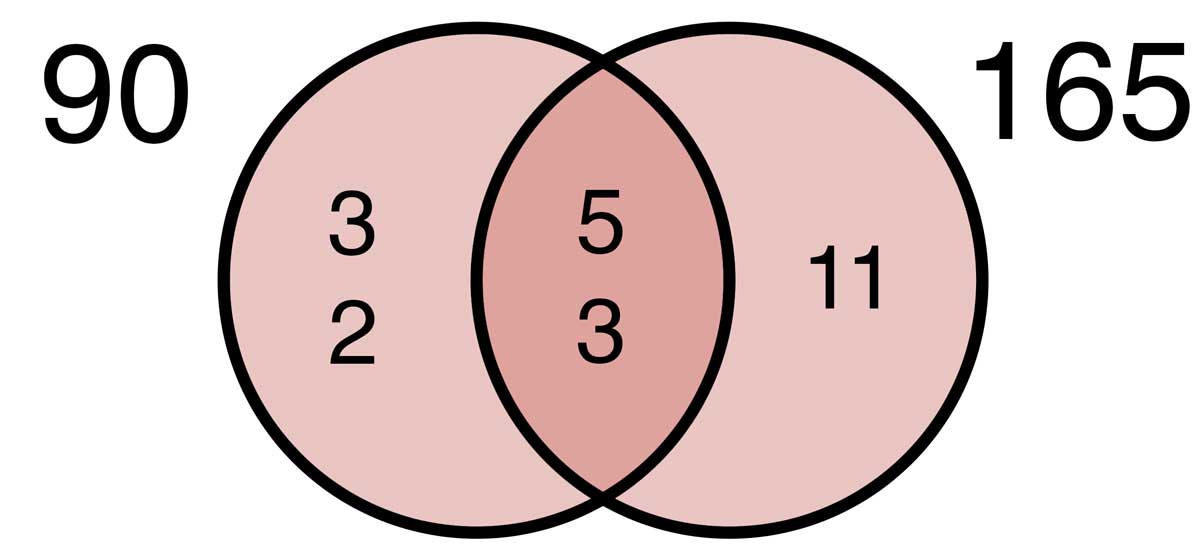GCF Calculator (Greatest Common Factor)
Find the greatest common factor, common factors, and all factors for a set of numbers using the calculator below.
Results: Greatest Common Factor
Steps to Solve:
On this page:
How to Find the Greatest Common Factor
The greatest common factor (GCF) of a set of numbers is the largest factor that is common to all the numbers in the set. The greatest common factor is sometimes referred to as the highest common factor (HCF), greatest common denominator (GCD), greatest common divisor, or highest common divisor.
A factor of a number x is a number that can be multiplied by another whole number to get x. For example, 3 and 5 are both factors of 15.
There are a few methods for finding the greatest common factor. The first is to use the calculator above, which even shows all the steps. Follow along below to learn about three more methods.

Method One: Find GCF Using Prime Factorization
One method to finding the greatest common factor of a set of numbers is to use prime factorization. To use prime factorization, find the prime factors of each number.
A prime number is a number that is only divisible by itself.
To find the prime factors, divide each number in the set by a prime factor. Then divide each number by another prime factor until they cannot be divided further. The prime numbers used to divide the number are the prime factors.
When you have the prime factors for each number in the set, the next step is to find the numbers that are common to all the numbers.
Finally, multiply all the common prime factors together to find the greatest common factor.
For example, let’s find the greatest common factor of 90 and 165 using prime factorization.
To find the prime factors of 90, divide 90 by 2 to get 45. 2 is a prime number, but 45 can be divided by 5 to get 9. 5 is a prime number, but 9 can be divided by 3 to get 3.
Thus, the prime numbers of 90 are [5,3,3,2].
Repeat this process for 165. 165 divided by 3 = 55. 3 is a prime factor, but 55 can be divided by 5 to get 11.
The prime factors of 165 are [11,5,3].
Now, find the prime factors that are common to both numbers. 5 and 3 are in both sets of prime factors we found above.
To find the greatest common factor, let’s multiply the common prime factors together.
5 × 3 = 15
Thus, 15 is the greatest common factor of 90 and 165.
Here’s a tip: use our prime factors calculator to find all prime factors of a number.
Method Two: Find GCF By Finding All Factors
Using this method, the greatest common factor is found by finding all the factors for each number in the set, then finding the factors common to all the numbers in the set. The largest factor common to all numbers is the greatest common factor.
To find the factors of a number, divide by a factor that you know goes into the number. For example, 2 will be a factor of all even numbers. Continue to divide each factor until you cannot divide the value any further.
Then, find the factors that are in the set of factors for all numbers. These are the common factors of the numbers.
Finally, find the largest number in the set of common factors. This is the greatest common factor.
For example, let’s find the greatest common factor of 90 and 165 by finding all factors.
Let’s start by finding the factors for both numbers.
The factors for 90 are [1, 2, 3, 5, 6, 9, 10, 15, 18, 30, 45, 90]
The factors for 165 are [1, 3, 5, 11, 15, 33, 55, 165]
Next, find the factors that are common to both 90 and 165.
The common factors are [1, 3, 5, 15]
Find the largest number in the set of common factors to find the greatest common factor.
The largest number in the set of common factors of 90 and 165 is 15. Thus, the greatest common factor of 90 and 165 is 15.
Method Three: Find GCF Using Euclid’s Algorithm
Euclid’s algorithm defines the steps to efficiently find the greatest common factor of two numbers. Start by dividing the large number by the small number to get the quotient and remainder.
If the remainder is not 0, then divide the previous divisor by the remainder. Continue doing this as long as the remainder is not 0. Once you have a remainder that equals 0, the divisor in that step is the greatest common factor.
For example, let’s find the greatest common factor of 90 and 165 using Euclid’s algorithm.
165 ÷ 90 = 1 remainder 75
90 ÷ 75 = 1 remainder 15
75 ÷ 15 = 5 remainder 0
Because 15 is the divisor in the final step, when the remainder equals 0, the GCF is 15.
Learn more using our Euclidean algorithm calculator.
Frequently Asked Questions
How are GCF and LCD different?
GCF (Greatest Common Factor) finds the largest number that divides evenly into two or more given numbers, while LCD (Least Common Denominator) finds the smallest number that is a multiple of two or more denominators in a set of fractions. GCF simplifies fractions by dividing both the numerator and denominator by the GCF, while LCD finds the common denominator when adding or subtracting fractions.
Can you find GCF on a calculator?
Calculators often have a built-in GCF function to quickly find the GCF of two or more numbers, although the specific method may vary depending on the calculator type.
For instance, scientific calculators may have a “GCF” or “gcd” function, while basic calculators may require manual calculation of factors. However, not all calculators have a GCF function, so alternative methods may be necessary.
What is the greatest common factor used for?
The greatest common factor is most commonly used to simplify or reduce fractions. The greatest common factor is also known as the greatest common divisor. Learn more about reducing fractions using our fraction simplifier.


